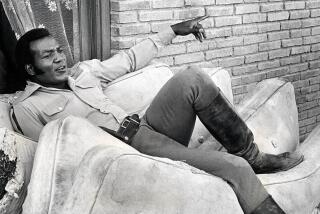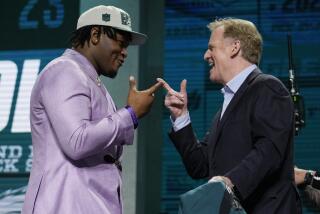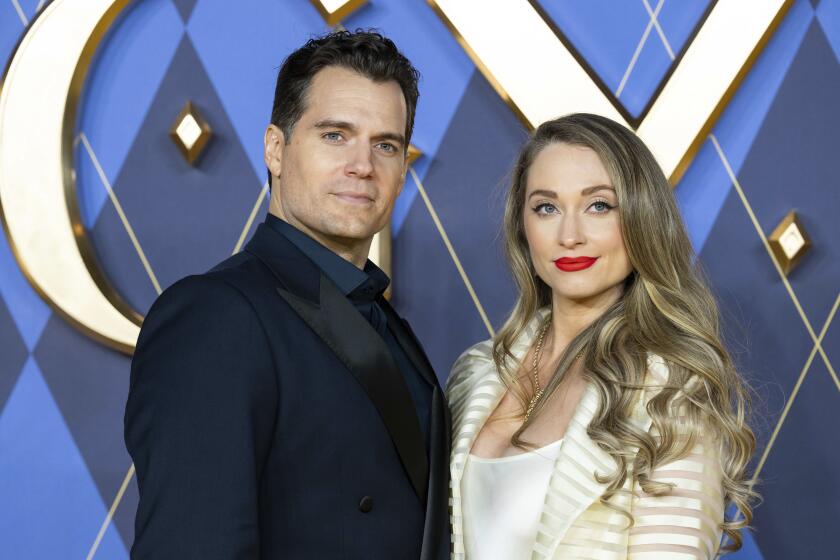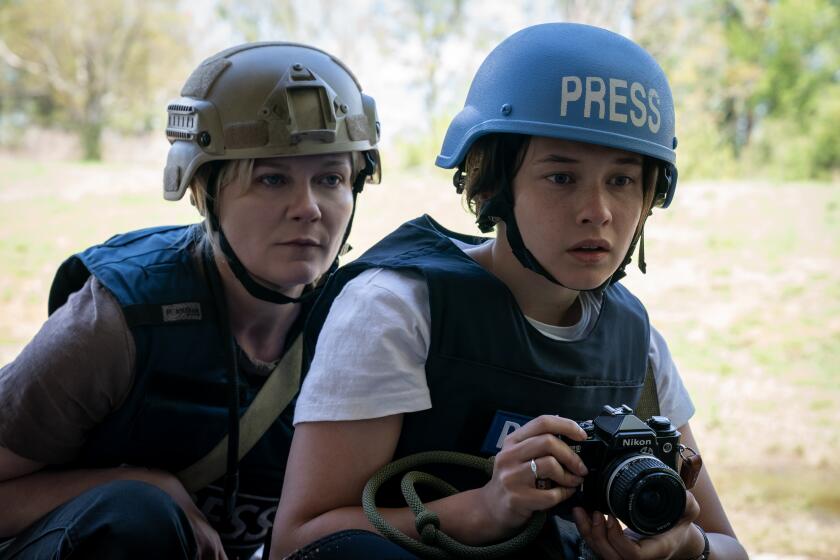NFL acts as team player in ‘Draft Day’
NEW YORK — In its ascent up the mountain of American popular culture, the NFL has studiously protected its brand, turning down many Hollywood offers to collaborate and limiting the extent of the partnerships it has forged.
So much for all that.
The NFL’s famously cautious mindset goes the way of leather helmets and the single-wing offense on Friday when Summit Entertainment releases “Draft Day,” a film from and about professional football. The movie — the product of a marriage brokered by Hollywood mainstay WME — thrusts the league into the world of big-time film and sets a new standard for cooperation between a professional sports entity and entertainment-world heavyweights.
Directed by comedy veteran Ivan Reitman and starring sports-pic fixture Kevin Costner, “Draft Day” blurs the line between movie plot and league showcase such that even savvy viewers may be unable to separate them. NFL personalities such as Ray Lewis and Jim Brown, broadcaster Rich Eisen and even commissioner Roger Goodell pop up in the fictional film, which locates scenes at various team facilities and sets and shoots its climax at the annual springtime college draft at Radio City Music Hall.
BEST MOVIES OF 2013: Turan | Sharkey | Olsen
By doing this, “Draft Day” — based on Rajiv Joseph and Scott Rothman’s script that topped Hollywood’s coveted Black List in 2012 — offers a level of behind-the-scenes authenticity rarely attempted in a scripted film about American pro sports. But as critics will point out, that also means the film can veer into infomercial territory and scrub out football’s less savory and more controversial aspects.
Unlike most sports dramas, “Draft Day” takes the action off the field and into the war room — think the trade scene in “Moneyball” — as it follows Costner’s fictitious Sonny Weaver, a beleaguered Cleveland Browns general manager as he wheels and deals in the pressure-cooker hours leading up to the big night. After mortgaging the team’s future in a trade with the Seattle Seahawks for the top overall pick, Weaver must grapple with questions about the player he should then select (several prospects are characters in their own right) and manage the delicate politics of coach, owner and players.
“This is one man’s story on a particularly complicated day when both personal and professional things are coming at him very fast,” Reitman said. “And it’s about the effect of a draft on hundreds of kids looking to fulfill a lifelong dream who must also meet the expectations of a lot of people.”
That kind of stress isn’t foreign to the NFL, either.
PHOTOS: Behind the scenes of movies and TV
In her office dotted with memorabilia at the league’s sleek midtown headquarters, Tracy Perlman recounted the decision to go all in on the movie. The NFL’s vice president for marketing and entertainment and its point person on “Draft Day,” Perlman and her fellow executives decided to move well beyond the occasional placement deal (of the kind it, say, did for a Minnesota Viking-centric episode of “How I Met Your Mother”) so it could serve a larger strategy.
Even with the NFL’s ratings the envy of rival leagues — the two championship games this year each topped 50 million viewers — the NFL is looking for new avenues of growth. This coming season it will expand with Thursday night games on CBS, while the league continues to try to fuel even more interest in the draft. Formerly an inside-the-Beltway affair centering on often obscure players and arcane physical attributes, the NFL in recent years has tried to turn it into a hotbed of drama and breathless detail on ESPN and the NFL Network.
The film, then, will look to reinforce these goals. “We believe this movie elevates the brand, it elevates the [draft] time period and it opens us up to new fans,” Perlman said.
Outgoing and possessing a keen sense of the NFL’s appeal (she also helms the Super Bowl halftime show), Perlman kept a watchful eye on “Draft Day.” The raw footage known as dailies was sent to her from the Ohio set and she would watch it regularly, sometimes passing along material and questions to different league divisions for their response, sometimes coming back with questions herself.
Much of this was done, as she puts it, “just to get the facts right,” such as the way trades and picks are made, a procedural aspect Reitman was eager to get right.
PHOTOS: Stars who turned down, or were turned down for, famous roles
But there was also scrutiny for other reasons. When a scene shot in Times Square showed a truck with a water brand that is not the official NFL sponsor, Perlman noticed and informed Reitman that it would need to either be dropped or altered.
When a version of the script came in with 51 four-letter words, Perlman made clear her feelings. “I said, ‘Ivan, do you realize there are 51 F-bombs in here?’ ” she laughed incredulously. (Most of the obscenities were taken out; the film now has a PG-13 rating.)
In a more fraught instance, Perlman and the league nixed a moment in which Seahawks fans can be seen, after a questionable draft move, expressing their displeasure.
“We had what I thought was a pretty funny bit where this one owner looks out the window and sees he’s being burned in effigy. And they just didn’t want that,” Costner said in an interview during CinemaCon in Las Vegas last month. “And I thought, ‘come on.’ ”
Perlman nodded knowingly when asked about this and allowed a small smile. “Yes, Kevin called me. I understood where he was coming from but we just couldn’t have that in the movie.” (For his part, Reitman said he thought “it would have gotten a big laugh” but that the NFL was “worried, and it was a small change, so we said OK.”)
The draft is not an immediately obvious cinematic subject. Joseph, the screenwriter, acknowledged he felt that way too until a chance encounter changed his mind. “I was having dinner with a friend who’s not a football fan and she said, ‘I loved the draft. It was interesting characters, high stakes and a ticking clock,’ ” the writer recalled. “I went back to Scott [Rothman] and said, ‘Isn’t this what great drama is?’ ”
PHOTOS: Biggest box office flops of 2013
Producer Ali Bell said she saw the film as something more primal than just a question of which team comes out on top. “The focus of the movie is football. The backdrop is power,” she said.
Written as a smaller character piece — the third-act drama at the draft was not in the script until Reitman came aboard — the script gained momentum WME, which works with the NFL, had set up a call between the league and Reitman. Soon after, the director flew to New York to pitch in a large meeting at the league offices. He wasn’t trying to make an expose, he explained; he just thought the drama of the draft was a ripe subject for cinema, and he wanted the league’s cooperation in putting it on display.
Perlman and Costner later met in London during the NFL’s annual game there (the actor was shooting the Jack Ryan movie in the city). “I think they wanted to be allayed,” Costner said, “that we took what they had done seriously.”
Some fans will notice that subjects such as concussions and what the NFL terms “health and safety” are absent from the film, while the unbridled excitement of the draftees belies the fact that many of the more than 200 players chosen in a given year end up with short workaday careers at best.
Asked if the NFL’s cooperation meant toning down any negative aspects, Reitman said, “I don’t think these things were relevant for our story. And our story couldn’t be told without the NFL.”
Bell added, “They never steered the story in a way that said you can’t do this or can’t do that. It was just about making it as authentic as possible.” (The league did not put in production funds but does have profit participation due to its efforts)
AS for making the movie, it wasn’t easy to shoot at various team facilities (more on that in a separate item) and it wasn’t simple to mount the film at Radio City on the actual days of the draft. On those days last spring, the crew would insert the actors, logos and other accouterments from the film early in the day before the actual event got underway, while Goodell and commentators such as ESPN’s Chris Berman and Jon Gruden would read the fictional names instead of the real ones they’d utter later.
Basically, instead of green-screening it, Reitman created an alternate version of the spectacle meant to look and feel like the original.
PHOTOS: Billion-dollar movie club
How fans will receive “Draft Day” remains to be seen. The NFL’s huge level of popularity will help, and the draft comes with some built-in element of suspense. Still, that sense of tension often resides with fans looking to take solace in (or get morose about) their team’s future. The movie’s gulf between real teams and fake players may deprive some of that investment.
Indeed, though Costner attempts some bold moves to turn the Browns around, the actual club was not so lucky — it gutted its front office between shooting and release.
“Everyone we worked with at the Cleveland Browns is no longer there,” Reitman said. He added, “As much as we tried to make this authentic, things can move fast in the NFL.”
Times staff writer Amy Kaufman contributed to this report.
More to Read
Only good movies
Get the Indie Focus newsletter, Mark Olsen's weekly guide to the world of cinema.
You may occasionally receive promotional content from the Los Angeles Times.







